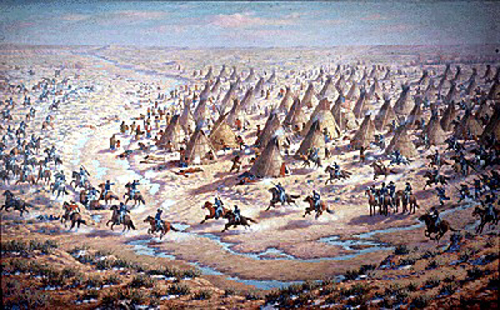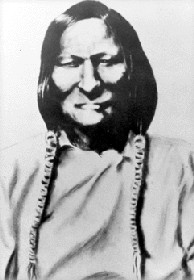NATIVE AMERICAN LEGENDS The Sand Creek Massacre

http://www.legendsofamerica.com/na-sandcreek.html
| |
|||
|
|||
|
One man, Silas Soule, a Massachusetts abolitionist, refused to follow Colonel Chivington's orders. He did not allow his cavalry company to fire into the crowd.
The troops kept up their indiscriminate assault for most of the day, during which numerous atrocities were committed. One lieutenant was said to have killed and scalped three women and five children who had surrendered and were screaming for mercy. Finally breaking off their attack they returned to the camp killing all the wounded they could find before mutilating and scalping the dead, including pregnant women, children and babies. They then plundered the teepees and divided up the Indians ' horse herd before leaving.
When the attack was over, as many as 150 Indians lay dead, most of which were old men, women and children. In the meantime, the cavalry lost only 9 or ten men, with about three dozen wounded. Black Kettle and his wife followed the others up the stream bed, his wife being shot several times, but somehow managed to survive.
The Colorado volunteers returned to Denver , exhibiting their scalps, to receive a hero's welcome. Initially the battle was reported in the press as a victory against a bravely-fought defense by the Cheyenne . Within weeks, however, eyewitnesses came forward offering conflicting testimony, leading to a military investigation and two Congressional investigations into the events. Silas Soule was eager to testify against Chivington . However, after he testified, Soule was murdered by Charles W. Squires, a murder believed to have been ordered by Chivington .
As the details came out, the US public was shocked by the brutality of the massacre. The congressional investigation subsequently determined the crime to be a "sedulously and carefully planed massacre." When asked at the military inquiry why children had been killed, one of the soldiers quoted Chivington as saying, "nits make lice." Though Chivington was denounced in the investigation and forced to resign, neither he nor anyone else was ever brought to justice for the massacre.
While the Sand Creek Massacre outraged easterners, it seemed to please many people in Colorado Territory. Chivington later appeared on a Denver stage where he regaled delighted audiences with his war stories and displayed 100 Indian scalps, including the pubic hairs of women.
As word of the massacre spread among the Indians of the southern and northern plains, their resolve to resist white encroachment stiffened. An avenging wildfire swept the land and peace returned only after a quarter of a century.
Through the years, the area of the Sand Creek Massacre has continued to be visited and commemorated. An aging John Chivington returned to the area in 1887, and in 1908 Veterans of the Colorado Regiments planned a reunion at the site. In August of 1950 the Colorado Historical Society assisted local residents and the Eads and Lamar Chambers of Commerce in placing a marker atop the bluff at the Dawson South Bend. Sand Creek descendants remain active in tribal communities in Montana , Oklahoma , and Wyoming – and Council Representatives continue to work alongside the National Park Service. However throughout, it has remained a controversial incident. And specifically in Colorado, it has traditionally been held as a founding victory for Colorado.
The Sand Creek Massacre was made a National Historic site on August, 2, 2005, almost a decade after Congress mandated the action in 1998. It has been delayed and troubled over the years due to controversy and disagreement, but was finally pulled together for a true remembrance of that horrible event in American History. In November of 2014, the Smithsonian Magazine pre-released an article for it's December addition entitled " The Horrific Sand Creek Massacre Will Be Forgotten No More " stating "The opening of a national historic site in Colorado helps restore to public memory one of the worst atrocities ever perpetrated on Native Americans". The article lays out not only the disputes over what occurred, but also the disagreements throughout the years over how, and even where, the Sand Creek Massacre should be remembered. You can read it here . |
|||




 The survivors, over half of whom were wounded, sought refuge in the camp of the
The survivors, over half of whom were wounded, sought refuge in the camp of the 
I can't find the other article with all the comments... what gives?
It was taken down, since one person only wanted to talk about AIM, which was not part of the article at all, Mimi.
It's about time someone put up a monument to those lost.
I don't understand why it wasn't done a long time ago...
Probably because those lost were Indians and the site was for so long largely regarded as a tribute to the brave men of the US Calvary who fought off those wicked, savage old men, women and children. The article states there were reunions held there and the sorry piece of shit who massacred them showed up for them.
Greasy Grass (Little Big Horn) was sacred to the white people for a century or more after that battle and George Armstrong Custer was elevated almost to the realm of a holy icon. In my childhood and teen years there were numerous films and TV movies showing him as such and the Indians as evil hell-spawn who tricked the Seventh Calvary to their deaths.
Truth is hard to come by when you are not the victor writing the history books.
21 medals of honor issue for killing women, children and old folks - nahhhh - doesn't sit well.
21 medals of honor issue for killing women, children and old folks - nahhhh - doesn't sit well
Is that where we started the idea of giving everyone a trophy for doing nothing worthy of note?
Hasn't quit, has it?


Sorry Mimi, it has been quite a while since mainstream historians and books have described Custer as a victim or hero. Yeah, the Errol Flynn movie that came out in 1940, I believe, cast Custer in a favorable light, but since then the favorable tributes to Custer have gotten fewer and farther between.
Oh. Thank you for the information, Kavika.
I didn't know, as I had to leave the house for a few minutes. I came back and read the comments posted in my absence and there were some I wanted to reply to... as you can guess, lol.
The response I made to his initial comment had nothing at all to do with AIM and I felt was valid; in fact when I read your comment to him, it was almost identical to mine.
Anyway, thanks for responding.
Please - let's discuss Sand Creek.